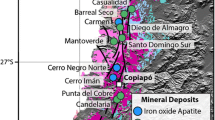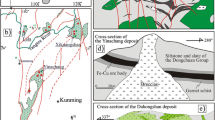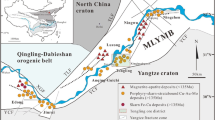Abstract
Interpretation of the mineralizing environment of magnetite-apatite deposits remains controversial with theories that include a hydrothermal or magmatic origin or a combination of those two processes. To address this controversy, we have analyzed the trace element content of magnetite from precisely known geographic locations and geologic environments from the Precambrian magnetite-apatite ore and host rocks in Kiruna, Sweden, and the Pliocene-Holocene El Laco volcano in the Atacama desert of Chile. Magnetite samples from Kiruna have low trace element concentrations with little chemical variation between the ore, host, and related intrusive rocks. Magnetite from andesite at El Laco, and dacite from the nearby Láscar volcano, has high trace element concentrations typical of magmatic magnetite. El Laco ore magnetite have low trace element concentrations and displays growth zoning in incompatible elements (Si, Ca, and Ce), compatible elements (Mg, Al, and Mn), large-ion lithophile element (Sr), and high field strength element (Y, Nb, and Th). The El Laco ore magnetite are similar in composition to magnetite that has been previously interpreted to have crystallized from hydrothermal fluids; however, there is a significant difference in the internal zoning patterns. At El Laco, each zoned element is either enriched or depleted in the same layers, suggesting the magnetite crystallized from a volatile-rich, iron-oxide melt. In general, the compositions of magnetite from these two deposits plot in very wide fields that are not restricted to the proposed fields in published discriminant diagrams. This suggests that the use of these diagrams and genetic models based on them should be used with caution.












Similar content being viewed by others
References
Alva-Vadivia LM, Rivas ML, Goguitchaichvili A, Urrutia-Fucugauchi J, Gonzalez JA, Morales J, Gómez S, Henríquez F, Nyström JO, Naslund RH (2003) Rock-magnetic and oxide microscopic studies of the El Laco ore deposits, Chilean Andes, and implications for magnetic anomaly modeling. Int Geol Rev 45:533–547
Barton MD, Johnson DA (1996) Evaporitic-source model for igneous-related Fe oxide-(REE-Cu-Au-U) mineralization. Geology 24:259–262
Barton MD, Johnson DA (2004) Footprints of Fe-oxide(−Cu-Au) systems. SEG 2004: predictive mineral discovery under cover. Centre for Global Metallogeny, Spec Pub 33:112–116
Bergman S, Kubler L, Martinsson O (2001) Description of regional geological and geophysical maps of northern Norrbotten County (east of the Caledonian orogen). Sveriges Geologiska Undersokning 56:110
Blake KL (1992) The petrology, geochemistry and association to ore formation of the host rocks of the Kiirunavaara magnetite-apatite deposit, northern Sweden. PhD thesis. University of Wales College of Cardiff, 307 pp.
Buddington AF, Lindsley DG (1964) Iron-titanium oxide minerals and synthetic equivalents. J Petrol 5(2):310–357
Cliff RA, Rickard D, Blake K (1990) Isotope systematics of the Kiruna magnetite ores, Sweden: part 1. Age of the ore. Econ Geol 85:1770–1776
Dahl PS (1979) Comparative geothermometry based on major-element and oxygen isotope distributions in Precambrian metamorphic rocks from southwestern Montana. Am Mineral 64:1280–1293
Dare SAS, Barnes S-J, Beaudoin G, Méric J, Boutroy E, Potvin-Doucet C (2014) Trace elements in magnetite as petrogenetic indicators. Mineral Deposita 49:785–796
Dare SAS, Barnes S-J, Beaudoin G (2015) Did the massive magnetite “lava flows” of El Laco (Chile) form by magmatic or hydrothermal processes? New constraints from magnetite composition by LA-ICP-MS. Mineral Deposita 50:607–617
Dupuis C, Beaudoin G (2011) Discriminant diagrams for iron oxide trace element fingerprinting of mineral deposit types. Mineral Deposita 46:319–335
Dymek RF, Owens BE (2001) Petrogenesis of apatite-rich rocks (nelsonites and oxide-apatite gabbronorites) associated with massif anorthosites. Econ Geol 96:797–815
Edfelt A, Armstrong RN, Smith M, Martinsson O (2005) Alteration paragenesis and mineral chemistry of the Tjarrojakka apatite-rion and Cu (−Au) occurrences, Kiruna area, northern Sweden. Mineral Deposita 40:409–434
Frietsch R (1978) On the magmatic origin of iron ores of the Kiruna type. Econ Geol 73:478–485
Frietsch R, Jan-Anders P (1995) Rare earth elements in apatite and magnetite in Kiruna-type iron ores and some other iron ore types. Ore Geol Rev 9:489–510
Frietsch R, Tuisku P, Martinsson O, Perdahl JA (1997) Early Proterozoic Cu-(Au) and Fe ore deposits associated with regional Na-Cl metasomatism in northern Fennoscandia. Ore Geol Rev 12:1–34
Geijer P (1910) Igneous rocks and iron ores of Kiirunavaara, Luossavaara and Tuollavaara. Scientific and practical researches in Lapland arranged by the Luossavaara-Kiirunavaara Aktiebolag - Geology of the Kiruna district, 2: Stockholm, p. 278
Geijer P (1919) Recent developments at Kiruna. SGU, C 288:23
Grigsby JD (1990) Detrital magnetite as a provenance indicator. J Sediment Petrol 60(6):940–951
Groves DI, Bierlein FP, Meinert LD, Hitzman MW (2010) Iron oxide copper-gold (IOCG) through Earth’s history: implications for origin, lithospheric setting, and distinction from other epigenic iron oxide deposits. Econ Geol 105:641–654
Hallberg A, Bergman T, Gonzalez J, Larsson D, Morris GA, Perdahl JA, Ripa M, Niiranen T, Eilu P (2012) Metallogenic areas in Sweden. Survey of Finland, Special Paper 53:139–206
Harlov DE, Andersson UB, Forster H-J, Nyström JO, Dulski P, Broman C (2002) Apatite-monazite relations in the Kiirunavaara magnetite-apatite ore, northern Sweden. Chem Geol 191:47–72
Henríquez F, Martin RF (1978) Crystal growth textures in magnetite flows and feeder dykes. El Laco, Chile, Can Miner 16:581–589
Henríquez F, Naslund HR, Nyström JO, Vivallo W, Aguirre R, Dobbs FM, Lledó H (2003) New field evidence bearing on the origin of the El Laco magnetite deposit, northern Chile-a discussion. Econ Geol 98:1497–1502
Hildebrand RS (1986) Kiruna-type deposits—their origin and relationship to intermediate subvolcanic plutons in the great bear magmatic zone, northwest Canada. Econ Geol 81:640–659
Hitzman MW (2000) Iron oxide-Cu-Au deposits: what, where, when, and why. In T. M. Porter (Ed.), Hydrothermal iron oxide copper-gold & related deposits a global perspective (pp. 9–26). PGC Publishing, Adelaide
Hitzman MW, Oreskes N, Einaudi MT (1992) Geological characteristics and tectonic setting of Proterozoic iron-oxide (Cu-U-Au-REE) deposits. Precambrian Res 58:241–287
Jochum KP, Willbold M, Raczek I, Stoll B, Herwig K (2005) Chemical characterisation of the USGS reference glasses GSA-1G, GSC-1G, GSD-1G, GSE-1G, BCR-2G, BHVO-2G and BIR-1G using EPMA, ID-TIMS, ID-ICP-MS and LA-ICP-MS. Geostandards and Geoanalytical Research 29(3):285–302
Kamenetsky VS, Charlier B, Zhitova L, Sharygin V, Davidson P, Feig S (2013) Magma chamber-scale liquid immiscibility in the Siberian Traps represented by melt pools in native iron. Geology 41(10):1091–1094
Knipping JL, Bilenker LD, Simon AC, Reich M, Barra F, Deditius AP, Wälle M, Heinrich CA, Holtz F, Munizaga R (2015) Trace elements in magnetite from massive iron oxide-apatite deposits indicate a combined formation by igneous and magmatic-hydrothermal processes. Geochim Cosmochim Acta 171:15–38
Lindsley DH (1976) The crystal chemistry and structure of oxide minerals as exemplified by the Fe-Ti oxides. In oxide minerals. Mineralogical Society of America, Short Course Notes 3:L-1 to L-60
Lindsley DH (1991) Oxide minerals: petrologic and magnetic significance. Reviews in Mineralogy, Volume 25, Stony Brook, New York, USA
LKAB (2015) Annual and sustainability report http://www.lkab.com/en/. Accessed 30 April 2016
Loberg BEH, Horndahl A-K (1983) Ferride geochemistry of Swedish Precambrian iron ores. Mineral Deposita 18:487–504
Martinsson O (1994) Greenstone and porphyry hosted ore deposits in northern Norbotten, NUTEK report nr 92-00752P: Luleå, p. 31.
Martinsson O (2004) Geology and metallogeny of the northern Norrbotten Fe-Cu-Au province: Society of Economic Geologists. Guidebook Series 33:131–148
Martinsson O, Billström K, Broman C, Weihed P, Wanhainen C (2016) Metallogeny of the northern Norrbotten ore province, northern Fennoscandian shield with emphasis on IOCG and apatite-iron ore deposits. Ore Geol Rev. doi:10.1016/j.oregeorev.2016.02.011
McCulloch MT, Gamble JA (1991) Geochemical and geodynamical constraints on subduction zone magmatism. Earth Planet Sci Lett 102:358–374
Mehdilo A, Irannajad M (2010) Applied mineralogical studies on Iranian hard rock titanium deposit. Journal of Minerals & Material Characterization & Engineering 9(3):247–262
Mucke A, Younessi R (1994) Magnetite-apatite deposits (Kiruna-type) along the Sanandaj-Sirjan zone and in the Bafq area. Iran, Associated with Ultramafic and Calcalkaline Rocks and Carbonatites: Mineralogy and Petrology 50:219–244
Muller B, Axelsson MD, Bjorn O (2003) Trace elements in magnetite from Kiruna, northern Sweden, as determined by LA-ICP-MS. GFF 125:1–5
Nadoll P, Angerer T, Mauk JL, French D, Walshe J (2014) The chemistry of hydrothermal magnetite: a review. Ore Geol Rev 61:1–32
Nadoll P, Mauk JL, Leveille RA, Koenig AE (2015) Geochemistry of magnetite from porphry Cu and skarn deposits in the southwestern United States. Miner Deposita 50:493–515
Naranjo JA, Henríquez F, Nyström JO (2010) Subvolcanic contact metasomatism at El Laco Volcanic Complex, central Andes. Andean Geol 37:110–120
Naslund HR, Henríquez FJ, Nyström JO, Vivallo W, Dobbs F (2002) Magmatic iron ores and associated mineralization: examples from the Chilean high Andes and Coastal Cordillera; in porter, T.M. (Ed.). Hydrothermal Iron Oxide Copper-Gold & Related Deposits: A Global Perspective, PGC Publishing, Adelaide 2:207–226
Nyström JO, Henríquez F (1994) Magmatic features of iron ores of the Kiruna type in Chile and Sweden; ore textures and magnetite geochemistry. Econ Geol 89:820–839
Nyström JO, Billström K, Henríquez F, Fallick AE, Naslund HR (2008) Oxygen isotope composition of magnetite in iron ores of the Kiruna type in Chile and Sweden. GFF 130:177–188
Nyström JO, Henríquez F, Naranjo JA, Naslund HR (2016) Magnetite spherules in pyroclastic iron ore at El Laco, Chile. Am Mineral 101:587–595
Parák T (1975) Kiruna iron ores are not “intrusive-magmatic ores of the Kiruna type”. Econ Geol 70:1242–1258
Park CF (1961) A magnetite “flow” in northern Chile. Econ Geol 56:431–436
Paton C, Hellstrom J, Paul B, Woodhead J, Hergt J (2011) Iolite: freeware for the visualisation and processing of mass spectrometric data. J Anal At Spectrom 26:2508–2518. doi:10.1039/c1ja10172b
Philpotts AR (1967) Origin of certain iron-titanium oxide and apatite rocks. Econ Geol 62:303–315
Ramanaidou E, Wells M, Belton D (2008) Mineralogical and microchemical methods for the characterization of high-grade banded iron formation-derived iron ore. SEG Reviews 15:129–156
Rhodes AL, Oreskes N (1999) Oxygen isotope composition of magnetite deposits at El Laco, Chile: evidence of formation from isotopically heavy fluids. Soc of Econ Geol, Spec Pub 7:333–351
Romer RL, Martinsson O, Perdahl JA (1994) Geochronology of the Kiruna iron ores and hydrothermal alterations. Econ Geol 89:1249–1261
Rudnick R, Gao S (2003) Composition of the continental crust. Treatise Geochem 3:1–64
Sabet-Mobarhan-Talab A, Alinia F, Ghannadpour S-S, Hezarkhani A (2015) Geology, geochemistry, and some genetic discussion of the Chadormalu iron oxide-apatite deposit, Bafq District, central Iran. Arab J Geosci 8:8399–8418
Sillitoe RH (2003) Iron oxide-copper-gold deposits: an Andean view. Mineral Deposita 38:787–812. doi:10.1007/s00126-003-0379-7
Sillitoe RH, Burrows DR (2002) New field evidence bearing on the origin of the El Laco magnetite deposit, northern Chile. Econ Geol 97:1101–1109
Storey CD, Smith MP, Jeffries TE (2007) In situ LA-ICP-MS U-Pb dating of metavolcanics of Norrbotten, Sweden: records of extended geological histories in complex titanite grains. Chem Geol 240:163–181
Tassi F et al (2009) The magmatic- and hydrothermal-dominated fumarolic system at the active crater of Láscar volcano, northern Chile. Bull Volcanol 71:171–183
Tornos F, Velasco F, Hanchar JM (2016) Iron oxide melts, magmatic magnetite and superheated magmatic-hydrothermal systems: the El Laco deposit, Chile. Geology 44(6):427–430
Valley PM, Hanchar JM, Whitehouse MJ (2011) New insights on the evolution of the Lyon mountain granite and associated Kiruna-type magnetite-apatite deposits, Adirondack Mountains, New York state. Geosphere 7:357–389
Velasco F, Tornos F (2012) Insights on the effects of the hydrothermal alteration in the El Laco magnetite deposit (Chile). Revista de la Sociedad Española de Mineralogía 16:210–211
Velasco F, Tornos F, and Hanchar, JM (2016) Immiscible iron- and silica-rich melts and magnetite geochemistry at El Laco volcano (northern Chile): Evidence for a magmatic origin for the magnetite deposits. Ore Geol Rev 79:346–366
Westhues A, Hanchar JM, Whitehouse MJ, Martinsson O (2016) New constraints on the timing of host rock emplacement, hydrothermal alteration and iron oxide apatite mineralization in and around Kiruna, Norrbotten region, northern Sweden. Econ Geol, in press
Williams PJ, Hedenquist JW, Barton MD, Johnson DA, Fontbote L, de Haller A, Mark G, Oliver NHS, Marschik R, Thompson JFH, Goldfarb RJ, Richards JP (2005) Iron oxide copper-gold deposits; geology, space-time distribution, and possible modes of origin. Econ Geol 100:371–405
Zipkin AM, Hanchar JM, Brooks AS, Grabowski MW, Thompson JC, Gomani-Chindebvu E (2015) Ochre fingerprints: Distinguishing among Malawian mineral pigment sources with Homogenized Ochre Chip LAICPMS. Archaeometry 57:297–317. doi:10.1111/arcm.12090
Acknowledgements
We would like to thank the Natural Sciences and Engineering Research Council of Canada (NSERC) discovery grant to JMH. The contribution of FT has been funded by the project SEIDI 2014 CGL2014-55949-R. Thanks to Luossavaara-Kiirunavaara Aktiebolag (LKAB) and Compañía Minera del Pacífico (CMP) for the help in logistics and permission to sample and granting access to the mine sites. We thank the reviewers (P. Williams and N. Oliver) for the thorough and constructive criticism of the original manuscript and to P. Williams for the comments on the revised manuscript. Thanks also to B. Lehmann for his review and editorial additions and handling of this paper.
Author information
Authors and Affiliations
Corresponding author
Additional information
Editorial handling: B. Lehmann
Electronic supplementary material
ESM 1
(XLSX 356 kb)
Rights and permissions
About this article
Cite this article
Broughm, S.G., Hanchar, J.M., Tornos, F. et al. Mineral chemistry of magnetite from magnetite-apatite mineralization and their host rocks: examples from Kiruna, Sweden, and El Laco, Chile. Miner Deposita 52, 1223–1244 (2017). https://doi.org/10.1007/s00126-017-0718-8
Received:
Accepted:
Published:
Issue Date:
DOI: https://doi.org/10.1007/s00126-017-0718-8




